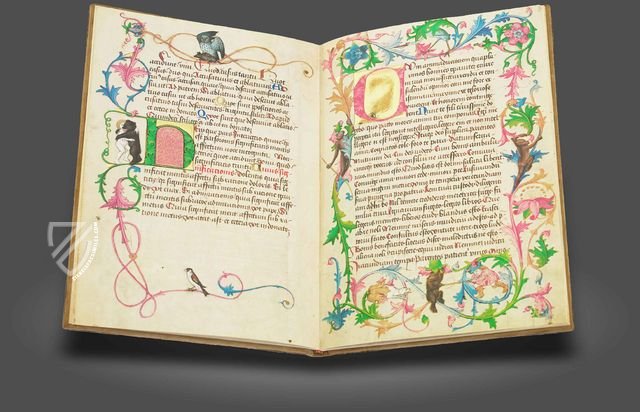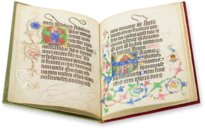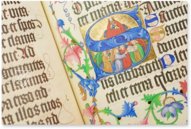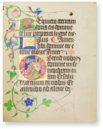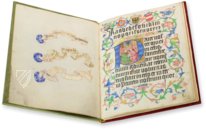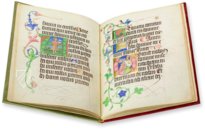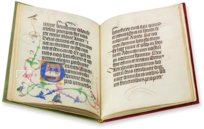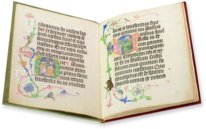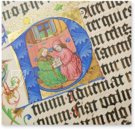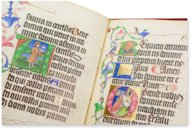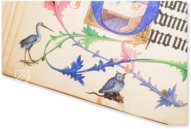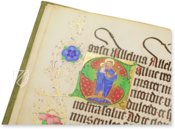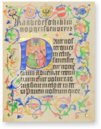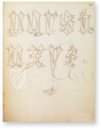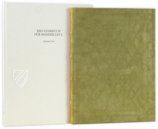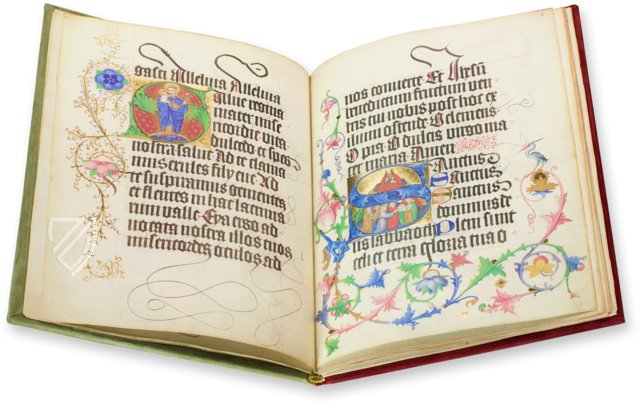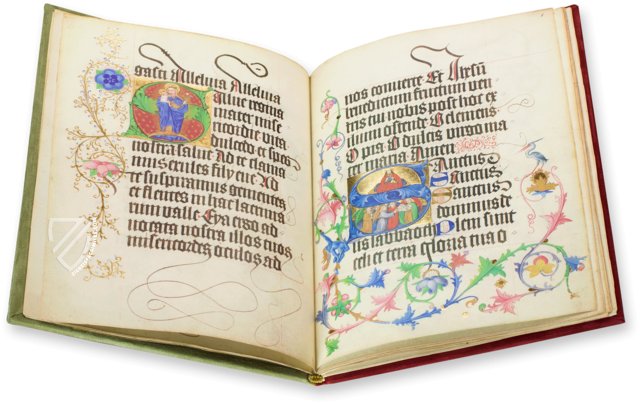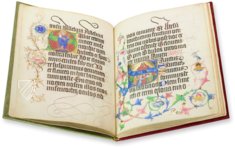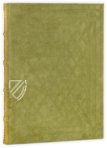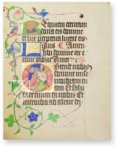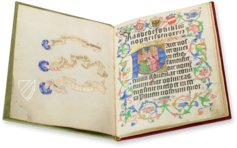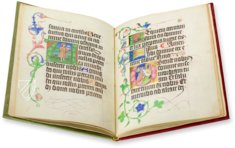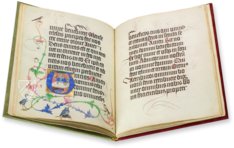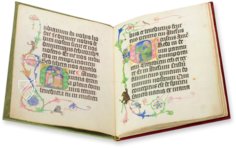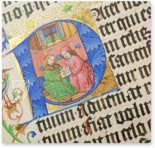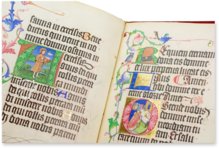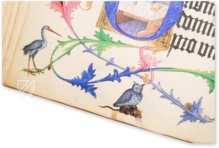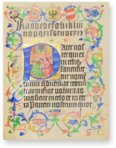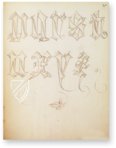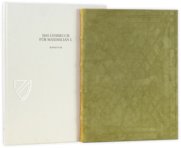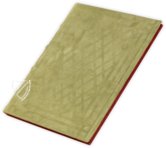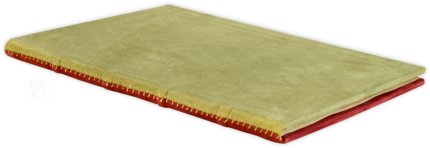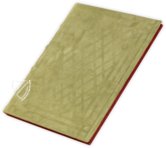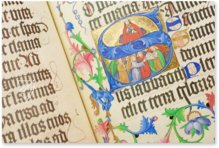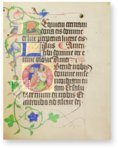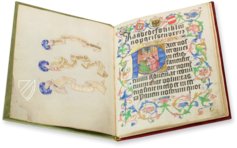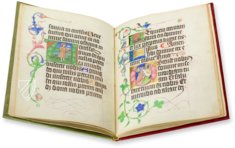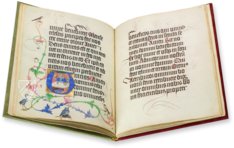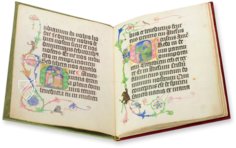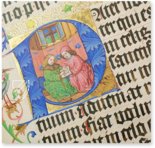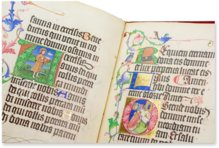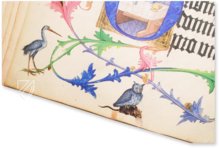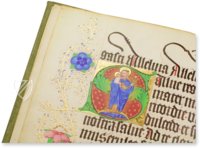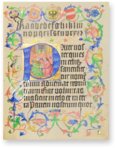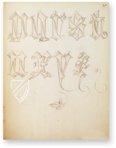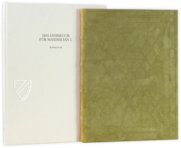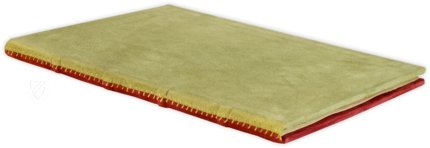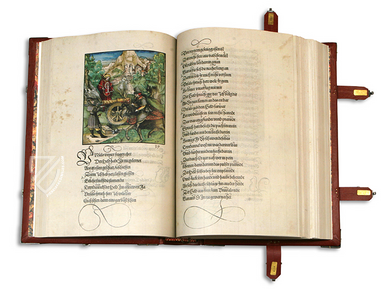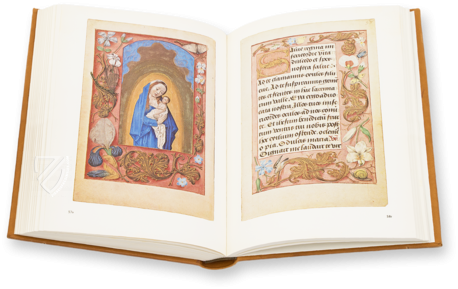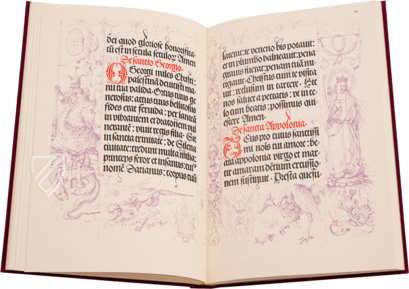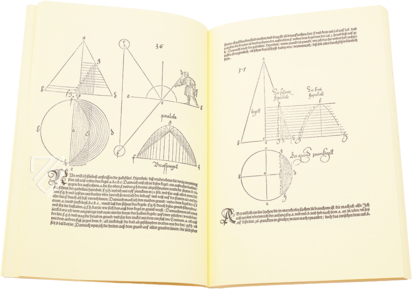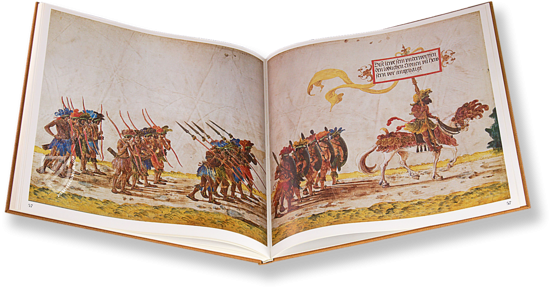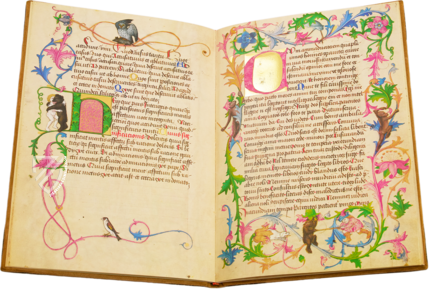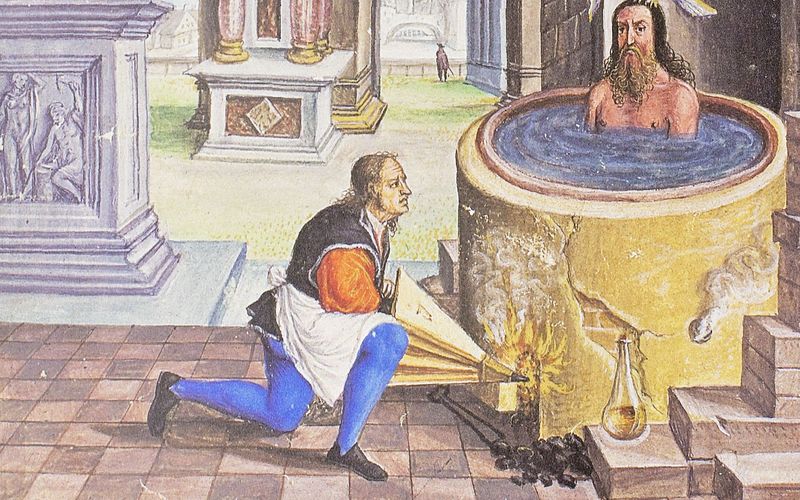Textbook for Emperor Maximilian
(3,000€ - 7,000€)
Rarely is world history so palpable as in this codex, which an emperor used to learn how to read and write: Maximilian I (1459–1519) led the Habsburgs to become the most powerful dynasty in Europe and went down in history as the "last knight" and father of the Landsknechte. However, even the most powerful man in Europe had to learn to read and write first. The viewer of this magnificently adorned manuscript can therefore look over the shoulder of the seven-year-old as he first learned the alphabet and then the Pater noster. In its historiated "P" initial, one can see little Maximilian eagerly deciphering the first letters with his finger together with his teacher, Jakob von Fladnitz. This and the 13 other opaque color miniatures of the historiated initials were intended to motivate the young ruler and, together with the rest of the creative design, such as the borders, also offer today's viewer a great delight.
Textbook for Emperor Maximilian
In the Middle ages, the basic subject matter in teaching was usually arranged with handwriting on simple blackboards, foldable paper boards, or even un-illustrated workbooks. Textbooks, richly decorated with miniatures, with a few exceptions, are exceedingly rare. One of the most valuable is the splendidly illuminated codex from Vienna, that is associated with the famous name of Maximilian I. From this school book, written about 1466 by the Imperial Chancellor Wolfgang Spitzweg, the young Emperor learned his ABC's and prayers such as the Our Father, Ave Maria, and more as well as jingles in the Latin and German languages: in short, all the basic contents of the medieval syllabus. The manuscript is the oldest copy of a group of three known textbooks that were specifically prepared for Maximilian and were all from the same master illuminator. In contrast to the author, the illuminator has remained anonymous. The colorful miniatures, richly decorated with gold, the illuminated initials, the genre scenes, and the religious representations show narrow references to the manorial student. From the beginning, we see Maximilian in one-on-one instruction with one of his teachers; when saying grace, the young prince always appears at table.
Inspired by Illumination at an Early Age
The cultural and historic meaning of the textbook to Maximilian I cannot be determined with sufficient accuracy. History highlights Maximilian I as being "the last knight and the first mercenary", and it is with this book that the versatilely gifted prince, under whom the Hapsburgs rose to be the mightiest dynasty of Europe, learned to read. The exquisite artistic production of this parchment manuscript was the first contact the young Maximilian had with illumination. It so excited him in its vitality that he became a major sponsor of the genre in later years. The manuscript features 14 miniatures inside of initials with polished gold backgrounds, each of which introduces a new section. Its floral frames feature a multitude of leafy tendrils, flowers, insects, animals, and people, indicating that it was the work of a very talented master. This illuminator has remained anonymous, but its author is known with certainty to be Wolfgang Spitzweg, an imperial clerk. Nonetheless, this work planted the artistic seed in young Maximilian, who would grow into one of the greatest art patrons of his day.
Codicology
- Alternative Titles
- Lehrbuch für Kaiser Maximilian I.
Liber in usum et instructionem Maximiliani filii Friderici III. imperatoris alphabetum, oratio dominica, preces latino-germanicae
Lehrbüchlein Maximilians I. - Size / Format
- 54 pages / 28.4 × 21.4 cm
- Origin
- Austria
- Date
- Around 1466
- Epochs
- Style
- Illustrations
- 14 historiated initials
- Patron
- Stephan Heuner
- Artist / School
- Wolfgang Spitzweg (scribe)
Master of the textbook for Emperor Maximilian I (illuminator)
Textbook for Emperor Maximilian
Young Maximilian at Prayer
This gorgeous pink historiated “O” initial with acanthus leaf décor was framed by glimmering gold leaf with a very finely embossed pattern. It contains a miniature of Prince Maximilian participating in mass, shown kneeling at the altar with a fine golden chalice alongside a tonsured priest who is dressed in elaborate vestments. Maximilian is depicted with long, flowing blond locks of hair and his pious expression might easily be interested by a modern beholder as boredom.
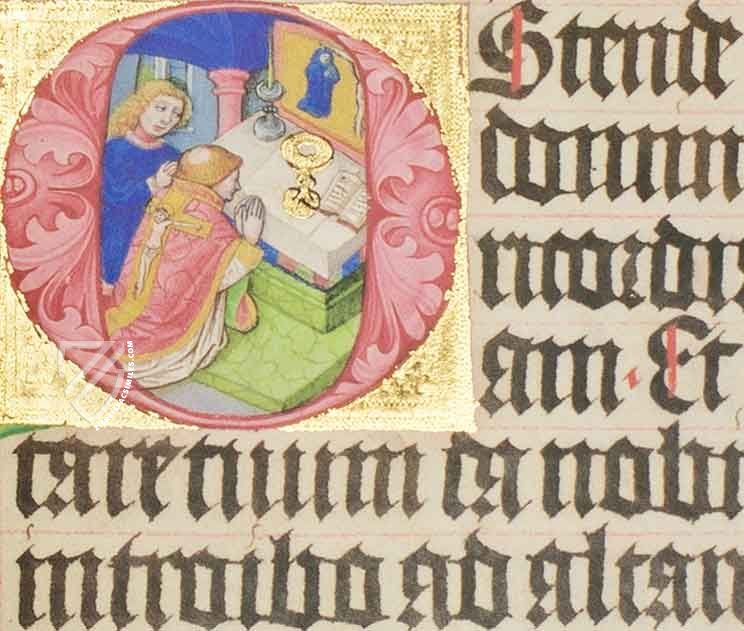
Textbook for Emperor Maximilian
Alphabet / Our Father Page
The opening page of this rare manuscript is framed by gorgeous flowering tendrils of red, green, and blue with a heron on the left margin and a face hidden at the bottom. At the top we see the Prince’s escutcheons: the red-and-white stripes of the Hapsburgs (right); the castles, shields, and fleur-de-lys of his Portuguese mother (left); the double-headed Reichsadler or Imperial Eagle (center).
We see the alphabet with several examples of the lowercase letter “a” above, while the rest of the page has the Our Father in Latin. It is adorned by the first of the manuscript’s 14 perfect historiated initials. The Prince is depicted in several of these with flowing blonde locks of hair, and in this case is wearing green-gold brocade and seated next to his tutor, dressed in red.
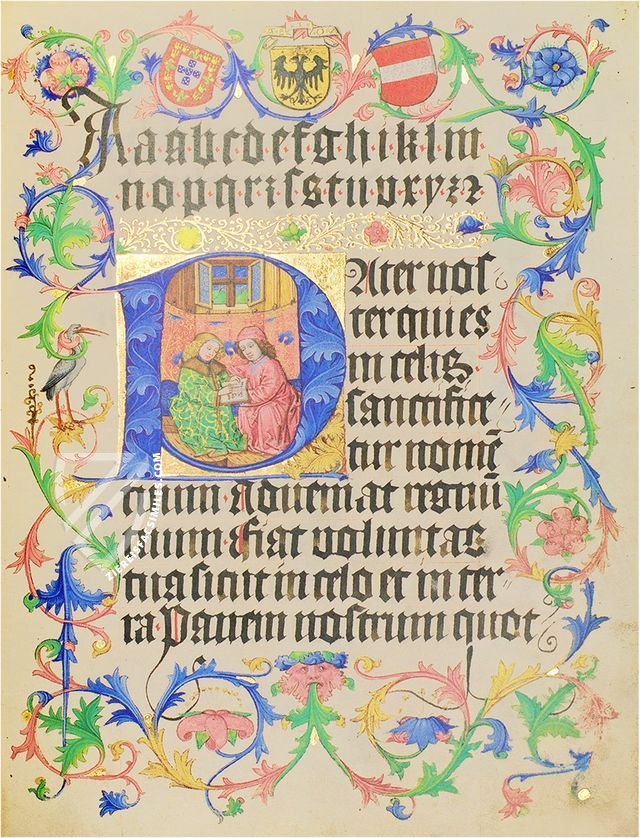
#1 Das Lehrbuch für Kaiser Maximilian (Real Gold Edition)
Language: German
(3,000€ - 7,000€)
#2 Das Lehrbuch für Kaiser Maximilian (Normal Edition)
Language: German
(1,000€ - 3,000€)
- Treatises / Secular Books
- Apocalypses / Beatus
- Astronomy / Astrology
- Bestiaries
- Bibles / Gospels
- Chronicles / History / Law
- Geography / Maps
- Saints' Lives
- Islam / Oriental
- Judaism / Hebrew
- Single Leaf Collections
- Leonardo da Vinci
- Literature / Poetry
- Liturgical Manuscripts
- Medicine / Botany / Alchemy
- Music
- Mythology / Prophecies
- Psalters
- Other Religious Books
- Games / Hunting
- Private Devotion Books
- Other Genres
- Afghanistan
- Armenia
- Austria
- Belgium
- Belize
- Bosnia and Herzegovina
- China
- Colombia
- Costa Rica
- Croatia
- Cyprus
- Czech Republic
- Denmark
- Egypt
- El Salvador
- Ethiopia
- France
- Germany
- Greece
- Guatemala
- Honduras
- Hungary
- India
- Iran
- Iraq
- Israel
- Italy
- Japan
- Jordan
- Kazakhstan
- Kyrgyzstan
- Lebanon
- Liechtenstein
- Luxembourg
- Mexico
- Morocco
- Netherlands
- Palestine
- Panama
- Peru
- Poland
- Portugal
- Romania
- Russia
- Serbia
- Spain
- Sri Lanka
- Sweden
- Switzerland
- Syria
- Tajikistan
- Turkey
- Turkmenistan
- Ukraine
- United Kingdom
- United States
- Uzbekistan
- Vatican City
- A. Oosthoek, van Holkema & Warendorf
- Aboca Museum
- Ajuntament de Valencia
- Akademie Verlag
- Akademische Druck- u. Verlagsanstalt (ADEVA)
- Aldo Ausilio Editore - Bottega d’Erasmo
- Alecto Historical Editions
- Alkuin Verlag
- Almqvist & Wiksell
- Amilcare Pizzi
- Andreas & Andreas Verlagsbuchhandlung
- Archa 90
- Archiv Verlag
- Archivi Edizioni
- Arnold Verlag
- ARS
- Ars Magna
- ArtCodex
- AyN Ediciones
- Azimuth Editions
- Badenia Verlag
- Bärenreiter-Verlag
- Belser Verlag
- Belser Verlag / WK Wertkontor
- Benziger Verlag
- Bernardinum Wydawnictwo
- BiblioGemma
- Biblioteca Apostolica Vaticana (Vaticanstadt, Vaticanstadt)
- Bibliotheca Palatina Faksimile Verlag
- Bibliotheca Rara
- Boydell & Brewer
- Bramante Edizioni
- Bredius Genootschap
- Brepols Publishers
- British Library
- C. Weckesser
- Caixa Catalunya
- Canesi
- CAPSA, Ars Scriptoria
- Caratzas Brothers, Publishers
- Carus Verlag
- Casamassima Libri
- Centrum Cartographie Verlag GmbH
- Chavane Verlag
- Christian Brandstätter Verlag
- Circulo Cientifico
- Club Bibliófilo Versol
- Club du Livre
- CM Editores
- Collegium Graphicum
- Collezione Apocrifa Da Vinci
- Comissão Nacional para as Comemorações dos Descobrimentos Portugueses
- Coron Verlag
- Corvina
- CTHS
- D. S. Brewer
- Damon
- De Agostini/UTET
- De Nederlandsche Boekhandel
- De Schutter
- Deuschle & Stemmle
- Deutscher Verlag für Kunstwissenschaft
- DIAMM
- Droz
- E. Schreiber Graphische Kunstanstalten
- Ediciones Boreal
- Ediciones Grial
- Ediclube
- Edições Inapa
- Edilan
- Editalia
- Edition Deuschle
- Edition Georg Popp
- Edition Leipzig
- Edition Libri Illustri
- Editiones Reales Sitios S. L.
- Éditions de l'Oiseau Lyre
- Editions Medicina Rara
- Editorial Casariego
- Editorial Mintzoa
- Editrice Antenore
- Editrice Velar
- Edizioni Edison
- Egeria, S.L.
- Eikon Editores
- Electa
- Emery Walker Limited
- Enciclopèdia Catalana
- Eos-Verlag
- Ephesus Publishing
- Ernst Battenberg
- Eugrammia Press
- Extraordinary Editions
- Fackelverlag
- Facsimila Art & Edition
- Facsimile Editions Ltd.
- Facsimilia Art & Edition Ebert KG
- Faksimile Verlag
- Feuermann Verlag
- Folger Shakespeare Library
- Franco Cosimo Panini Editore
- Friedrich Wittig Verlag
- Fundación Hullera Vasco-Leonesa
- G. Braziller
- Gabriele Mazzotta Editore
- Gebr. Mann Verlag
- Gesellschaft für graphische Industrie
- Getty Research Institute
- Giovanni Domenico de Rossi
- Giunti Editore
- Graffiti
- Grafica European Center of Fine Arts
- Guido Pressler
- Guillermo Blazquez
- Gustav Kiepenheuer
- H. N. Abrams
- Harrassowitz
- Harvard University Press
- Helikon
- Hendrickson Publishers
- Henning Oppermann
- Herder Verlag
- Hes & De Graaf Publishers
- Hoepli
- Holbein-Verlag
- Houghton Library
- Hugo Schmidt Verlag
- Idion Verlag
- Il Bulino, edizioni d'arte
- ILte
- Imago
- Insel Verlag
- Insel-Verlag Anton Kippenberger
- Instituto de Estudios Altoaragoneses
- Instituto Nacional de Antropología e Historia
- Introligatornia Budnik Jerzy
- Istituto dell'Enciclopedia Italiana - Treccani
- Istituto Ellenico di Studi Bizantini e Postbizantini
- Istituto Geografico De Agostini
- Istituto Poligrafico e Zecca dello Stato
- Italarte Art Establishments
- Jan Thorbecke Verlag
- Johnson Reprint Corporation
- Josef Stocker
- Josef Stocker-Schmid
- Jugoslavija
- Karl W. Hiersemann
- Kasper Straube
- Kaydeda Ediciones
- Kindler Verlag / Coron Verlag
- Kodansha International Ltd.
- Konrad Kölbl Verlag
- Kurt Wolff Verlag
- La Liberia dello Stato
- La Linea Editrice
- La Meta Editore
- Lambert Schneider
- Landeskreditbank Baden-Württemberg
- Leo S. Olschki
- Les Incunables
- Liber Artis
- Library of Congress
- Libreria Musicale Italiana
- Lichtdruck
- Lito Immagine Editore
- Lumen Artis
- Lund Humphries
- M. Moleiro Editor
- Maison des Sciences de l'homme et de la société de Poitiers
- Manuscriptum
- Martinus Nijhoff
- Maruzen-Yushodo Co. Ltd.
- MASA
- Massada Publishers
- McGraw-Hill
- Metropolitan Museum of Art
- Militos
- Millennium Liber
- Müller & Schindler
- Nahar - Stavit
- Nahar and Steimatzky
- National Library of Wales
- Neri Pozza
- Nova Charta
- Oceanum Verlag
- Odeon
- Orbis Mediaevalis
- Orbis Pictus
- Österreichische Staatsdruckerei
- Oxford University Press
- Pageant Books
- Parzellers Buchverlag
- Patrimonio Ediciones
- Pattloch Verlag
- PIAF
- Pieper Verlag
- Plon-Nourrit et cie
- Poligrafiche Bolis
- Presses Universitaires de Strasbourg
- Prestel Verlag
- Princeton University Press
- Prisma Verlag
- Priuli & Verlucca, editori
- Pro Sport Verlag
- Propyläen Verlag
- Pytheas Books
- Quaternio Verlag Luzern
- Reales Sitios
- Recht-Verlag
- Reichert Verlag
- Reichsdruckerei
- Reprint Verlag
- Riehn & Reusch
- Roberto Vattori Editore
- Rosenkilde and Bagger
- Roxburghe Club
- Salerno Editrice
- Saltellus Press
- Sandoz
- Sarajevo Svjetlost
- Schöck ArtPrint Kft.
- Schulsinger Brothers
- Scolar Press
- Scrinium
- Scripta Maneant
- Scriptorium
- Shazar
- Siloé, arte y bibliofilia
- SISMEL - Edizioni del Galluzzo
- Sociedad Mexicana de Antropología
- Société des Bibliophiles & Iconophiles de Belgique
- Soncin Publishing
- Sorli Ediciones
- Stainer and Bell
- Studer
- Styria Verlag
- Sumptibus Pragopress
- Szegedi Tudomànyegyetem
- Taberna Libraria
- Tarshish Books
- Taschen
- Tempus Libri
- Testimonio Compañía Editorial
- Thames and Hudson
- The Clear Vue Publishing Partnership Limited
- The Facsimile Codex
- The Folio Society
- The Marquess of Normanby
- The Richard III and Yorkist History Trust
- Tip.Le.Co
- TouchArt
- TREC Publishing House
- TRI Publishing Co.
- Trident Editore
- Tuliba Collection
- Typis Regiae Officinae Polygraphicae
- Union Verlag Berlin
- Universidad de Granada
- University of California Press
- University of Chicago Press
- Urs Graf
- Vallecchi
- Van Wijnen
- VCH, Acta Humaniora
- VDI Verlag
- VEB Deutscher Verlag für Musik
- Verlag Anton Pustet / Andreas Verlag
- Verlag Bibliophile Drucke Josef Stocker
- Verlag der Münchner Drucke
- Verlag für Regionalgeschichte
- Verlag Styria
- Vicent Garcia Editores
- W. Turnowski Ltd.
- W. Turnowsky
- Waanders Printers
- Wiener Mechitharisten-Congregation (Wien, Österreich)
- Wissenschaftliche Buchgesellschaft
- Wissenschaftliche Verlagsgesellschaft
- Wydawnictwo Dolnoslaskie
- Xuntanza Editorial
- Zakład Narodowy
- Zollikofer AG

